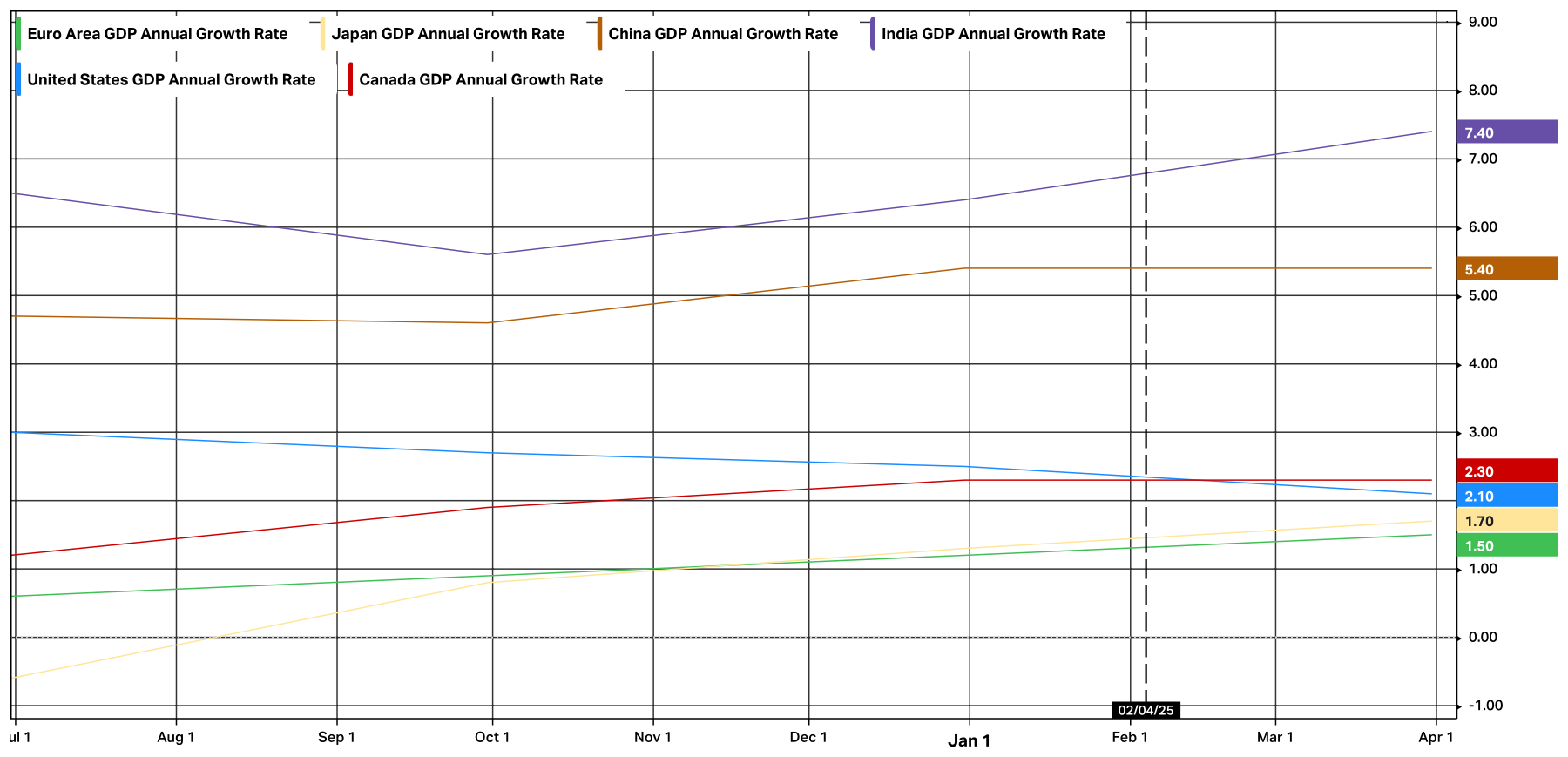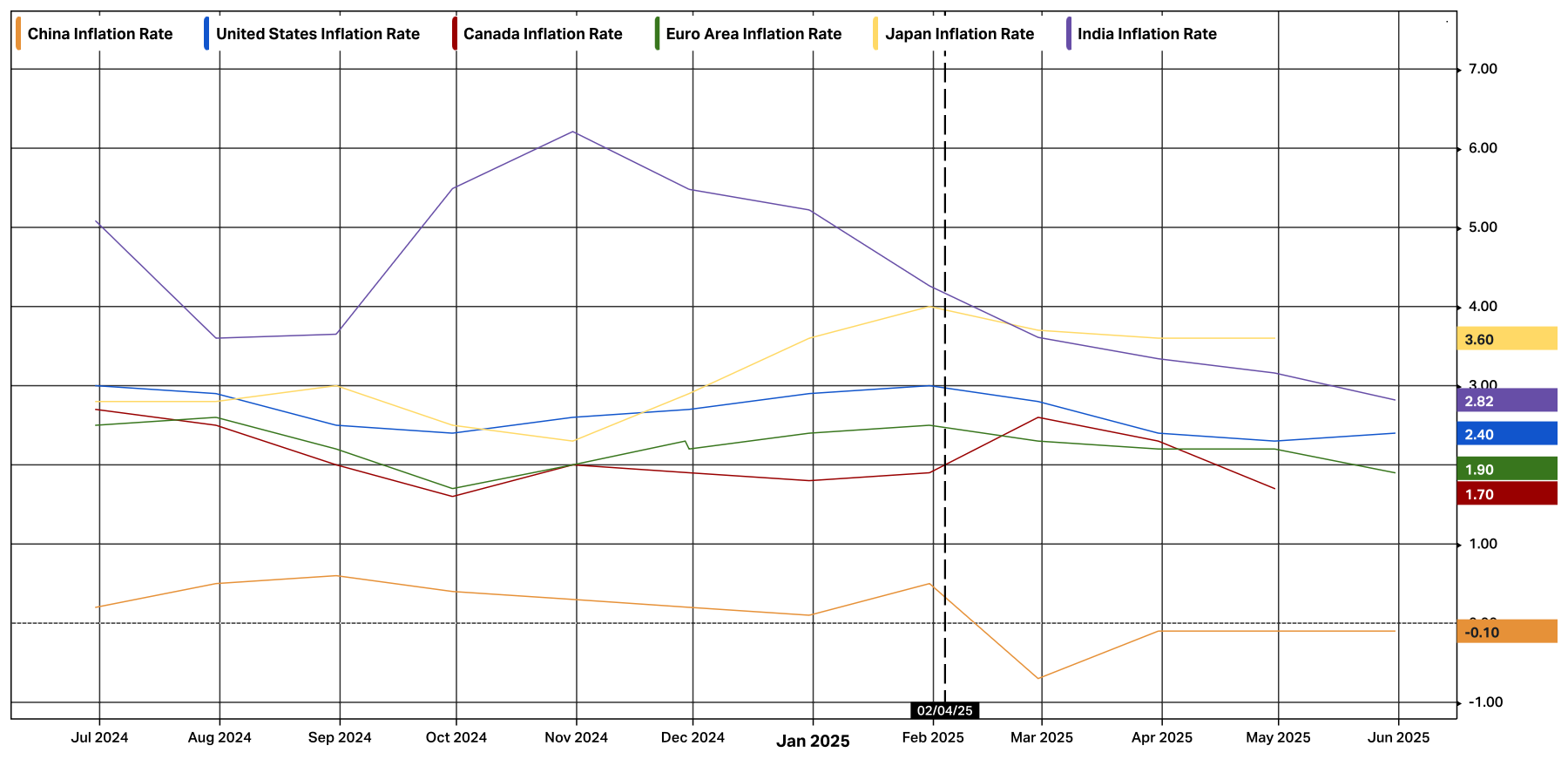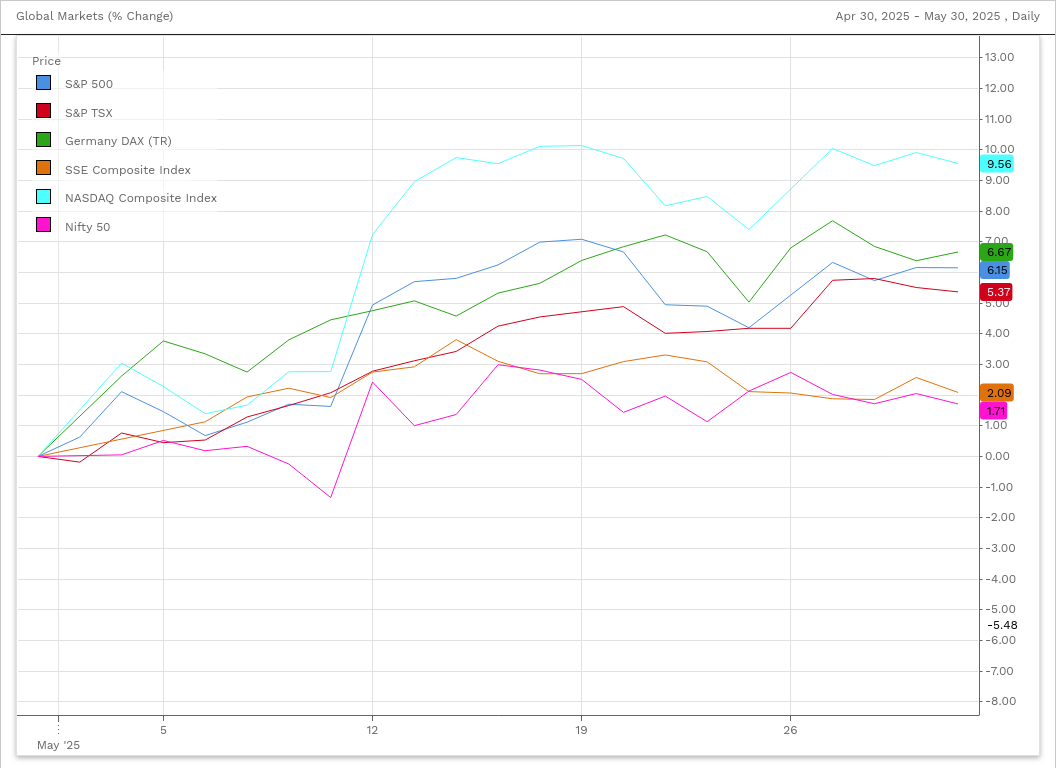| Monthly Market Analysis June 2025 |
| Economy The Trump Administration’s Ongoing Tariff Negotiations We are rapidly approaching July 9th, the self-imposed date that the United States has demanded that its global trade partners must negotiate a trade deal to avoid being charged a “reciprocal tariff” above the current 10% baseline rate. Other than an outline of a trade deal with the United Kingdom and a trade de-escalation deal with China, there have been no announced trade deals. Members of Trump’s trade team have indicated that they will likely extend the July 9th deadline for “good faith” negotiations to continue with countries that are actively negotiating with their team. On May 28th, the U.S. Court of International Trade issued a permanent injunction blocking the enforcement of tariffs issued under the International Emergency Economics Powers Act (IEEPA). The Trump tariffs enacted under the IEEPA include the 25% tariffs on Canadian and Mexican goods, and the “reciprocal tariffs” (temporarily at a 10% base rate, while final tariff rates are negotiated) levied on most other countries around the world. The Trump administration has appealed the court’s decision, and the order has been stayed while the case is being appealed. The U.S. Supreme court will likely need to make the final decision on the validity of Trump using the International Emergency Economics Powers Act to levy tariffs on the entire globe. On June 4, the Trump administration increased tariffs on steel and aluminum from 25% to 50%. Trump Tariffs Tariffs on American imports are expected to increase the price of goods for American consumers and cut into the profits of American businesses. Nevertheless, the Trump administration has decided to utilize import tariffs to achieve their priorities: 1. Tariffs are being implemented to encourage companies to manufacture their products in the United States. The Trump administration assumes that companies will eventually produce their products in the United States to avoid tariffs. 2. The revenue from tariffs will be used to help pay for the extension of expiring tax reduction legislation, which was originally enacted in 2017 during Donald Trump’s first administration. The Congressional Budget Office estimates the cost of extending the 2017 tax cut legislation for ten additional years would be $4.6 Trillion. 3. Tariffs on U.S goods are being implemented to help eliminate the American trade deficit with other countries. The U.S. tariffs will be used as leverage to coerce other countries to lower their own tariffs and non-tariff barriers. 4. Tariffs are being used as punishment for countries that refuse to carry out American demands. Active Trump Tariffs Implemented in 2025* • 30% tariff on Chinese goods. • 10% tariff on Eurozone goods. • 25% tariff on Canadian Goods (Except goods covered under the Canada-United States-Mexico trade agreement). Canada has responded with retaliatory tariffs • 25% tariff on Mexican Goods (Except goods covered under the Canada-United States-Mexico trade agreement) • 50% tariff on all steel and aluminum imports into the United States. Canada and the European Union have responded with retaliatory tariffs. • 10% minimum tariff on all goods imported into the United States. • 25% tariff on all automobiles not assembled in the United States. *All tariff rates are now being negotiated between individual countries or trading blocks and the Trump administration. Conditions in which Trump Tariffs will be Lowered or Eliminated 1. Legal: Trump’s tariffs mostly contravene international trade law, but enforcing these laws can be a long, tedious process often with no enforceable remedies. American industries that are impacted by Trump’s tariffs often have lobby groups that can challenge the legality of the Trump tariffs in U.S. courts. The United States Congress could also intervene, since tariffs are typically under their purview, but Republicans have a majority in Congress and are unlikely to move against their party leader. 2. Political Backlash: The negative impact of higher consumer prices in the United States and/or the unavailability of needed/desired goods due to retaliatory actions taken by other countries may generate political backlash from U.S. consumers and businesses. 3. Trade Negotiations: At any time, trade negotiations between the United States and its trading partners around the world could lower or eliminate the newly enacted tariffs. 4. U.S. Midterm Elections: In November 2026, U.S. Congressional Elections may change the political environment. If American voters are unhappy with how the Trump tariffs are impacting their lives, Republicans could lose their majority in Congress. 5. Four Year Presidential Term: In less than four years Donald Trump will complete his second and final term as the President of the United States of America. A newly elected American President could undo the Trump tariffs, if they are still in place. Global Economic Growth (Annualized GDP Growth Rate) After Trump Tariffs – 1 Year Chart Global Annual GDP Growth Rates after Trump Tariffs (Trump tariffs started on February 4th): The U.S. economy’s (blue) annual growth rate declined from 2.5% to 2.1%. The Canadian economy’s (red) annual growth rate was unchanged at 2.3%. China’s annual economic growth rate was unchanged at 5.4%. The Eurozone’s annual economic growth rate (green) increased from 1.2% to 1.5%. The Japanese annual economic growth rate (yellow) rose from 1.30% to 1.70%. India’s annual economic growth rate (purple) increased from 6.4% to 7.4%.  Global Inflation Rates (Annualized) After Trump Tariffs – 1 Year Chart Global Annual Inflation Rates after Trump Tariffs (Trump tariffs started on February 4th): Since the Trump tariffs were implemented the inflation rate for all the tracked economies have moved lower. Canada’s inflation rate (red) dropped from 1.9% to 1.7%, United States’ inflation rate (blue) declined from 3.0% to 2.4%, the Eurozone inflation rate (green) fell from 2.5% to 1.9%, China’s inflation rate (orange) declined from 0.5% to -0.10%, Japan’s inflation rate (yellow) fell from 4.0% to 3.6%, and India’s inflation rate (purple) fell from 4.26% to 2.82%.  United States The growth of the United States labour market has moderated in 2025 but is still growing at a reasonable pace. The average monthly job growth in the U.S. during 2024 was 186,000/month (U.S. Bureau of Labour Statistics), in 2025 it is averaging 123,800/month. In the month of May 139,000 additional jobs were generated, while the unemployment rate remained at 4.2%. Initial Jobless Claims (the amount of people applying for new jobless benefits in one week) has been steadily rising in the United States and has now reached 247,000 for the week ending May 31st. Consumers have not cut back on spending in the United States as retail sales grew by 0.1% in April. We will get May’s retail data on June 17th. The U.S. inflation rate rose from 2.3% to 2.4% in May, which is less than most economists had expected. Based on the rising inflation rate and reasonable job growth The U.S. Federal Reserve decided to keep rates unchanged during their meeting in May. Canada The Canadian labour market had another positive month of growth in May, although only 8,800 jobs were generated. The unemployment rate moved up for the fourth consecutive month, increasing from 6.9% to 7.0% in May. Consumers continue to spend in Canada, during the month of March retail sales grew by 0.8%. The inflation rate in Canada continues to defy expectations as it dramatically fell from 2.3% to 1.7%, in April. Given that the inflation rate is now below their target rate and U.S. tariff rates are uncertain, the Bank of Canada decided to leave interest rates unchanged at 2.75% during their June 4th meeting. Markets Global stock markets continue to rebound as market participants are relieved that there have not been any additional tariffs levied on imports by the Trump administration. During the month of May, the U.S. Market (S&P 500) was up 6.15% while the Canadian market (S&P/TSX Composite Index) was up 5.37%. The U.S. Nasdaq Composite index which contains a high weighting of technology related stocks was up 9.56%. The German stock market (Dax 40 index) increased by 6.67%, while the Chinese market (Shanghai Composite Index) increased by 2.09% and the Indian market (Nifty 50 Index) was up 1.71%. Change in Global Stock Markets May 1 – May 30, 2025  In May, the United States and China had a trade skirmish about the speed of rare earth minerals shipments from China, it was resolved quickly. The market has digested recent developments such as the doubling of steel and aluminum tariffs and the full-scale war between Israel and Iran. If the Israel-Iranian war expands to other parts of the middle east or impacts the production or distribution of oil, global equity markets may not respond favourably. We should expect some trade deals or trade frameworks to be announced over the next few weeks, before July 9th, but it appears that negotiations will continue beyond that date. Markets will continue to be driven by U.S. trade developments and U.S. economic data, especially inflation and employment numbers. |
| 1 (Source: Bank of Canada) 2(Source: Statistics Canada) 3(Source: United States Bureau of Labour Statistics) 4(Source: United States Federal Reserve) 5(Source: United States Census Bureau) 6(Source: FactSet as of June 13, 5:00 PM) *This information has been prepared by Desmond Rubie, BCom, FCSI®, CIM®, CFP®, who is a Wealth Advisor for Rubie Wealth Management Group at iA Private Wealth. Opinions expressed in this article are those of Desmond Rubie, BCom, FCSI®, CIM®, CFP® only and do not necessarily reflect those of iA Private Wealth Inc. *IA Private Wealth Inc. is a member of the Canadian Investor Protection Fund and the Canadian Investment Regulatory Organization. iA Private Wealth is a trademark and business name under which iA Private Wealth Inc. operates.  Desmond Rubie, BCom, FCSI®, CIM®, CFP® Wealth Advisor Rubie Wealth Management Group | iA Private Wealth Insurance Advisor | iA Private Wealth Insurance* 26 Wellington Street East, 2nd FloorToronto, ON M5E 1S2 T: 647-429-3281 ext. 240018 Desmond.Rubie@iaprivatewealth.ca Schedule a Meeting rubiewealth.com Fellow of CSI (FCSI®) iA Private Wealth Inc. is a member of the Canadian Investor Protection Fund and the Canadian Investment Regulatory Organization. iA Private Wealth is a trademark and business name under which iA Private Wealth Inc. operates. *Insurance products are provided through iA Private Wealth Insurance, which is a trade name of PPI Management Inc. Only products and services offered through iA Private Wealth Inc. are covered by the Canadian Investor Protection Fund. |

Leave a Reply